小学牛津英语5A语法归纳
牛津英语小学五年级5A知识点

Unit one重点解析1. Is there a/an.... in/on/near the...?Yes, there is. /No, there isn't.Are there any ... in the...?Yes, there are. / No, there aren't.讲解:(1)把be动词(is/ are)提到句首即可构成一般疑问句。
(2)回答时用Yes或No。
举例:Yes, there is/there are. No, there isn't/there aren't.(3)在一般疑问句中some通常变成any。
如:举例:Are there any students in the classroom?教室里有学生吗?Is there any water in the glass? 玻璃杯里有水吗?2. How many ... are there in the...? There are....讲解:本句型为there be句型的特殊疑问句形式,表示“在某处某物的数量有多少”。
(1)how many 后跟复数名词。
举例:how many reading rooms 多少个阅览室how many books 多少本书(2)特殊疑问句= how many + 名词复数+ 一般疑问语序(is/are there)。
举例:How many apples are there in the tree?树上有多少个苹果?How many books are there in the bookcase?书柜里有多少本书?(3)回答时不能用Yes或No, 要给出具体的回答。
举例:―How many students are there in the room?房间里有多少名学生?―There are two.有两名。
3. the first day of the new term 新学期的第一天讲解:“of”表示“……的”,在这里是所有格的用法,主要用于表示无生命的名词,举例:the door of the house 房子的门a map of China 一张中国地图4. the first floor 1楼讲解:“first”意思是“第一”。
牛津小学英语5A语法知识总结

牛津小学英语5A语法(yǔfǎ)知识总结牛津(niú jīn)小学英语5A语法知识总结5U1-U9语法知识(zhī shi)总结内容(nèiróng)肯定句否认(fǒurèn)句一般疑问句及答复Isthereapeninthebo某Yes,thereis./No,thereisn’t.Arethereanypensinthebo某Yes,thereare./No,therearen’t.CanI/you/he/she/itdance Yes,I/you/he/she /itcan.No,I/you/he/she/itcannot(can’t).Canwe/you/theydanceYes,I/you/ he/she/itcan.No,I/you/he/she/itcannot(can’t).DoI/youlike/needanymask sYes,you/Ido./No,you/Idon’t.Dowe/You/TheyneedanymasksYes,you/we/they do./No,you/we/theydon’t.AmIreadingYes,youare./No,youaren’t.Areyoure adingYes,Iam./No,I’mnot.Ishe/she/itreadingYes,he/she/itis./No,/she/i tisn’t.Arewe/you/theyreadingYes,we/you/theyare./No,we/you/theyaren’t.特殊疑问句及答复Howmanypensarethereinthebo某There’s/Thereare…What’sinthebo某There’s/Thereare…Whatc anI/youhe/she/itdoYou/Ihe/she/itcandance.What canwe/you/theydoWe/you/theycandance.therebe单数:There’sapeninthebo 某.句型复数:(U1-2)单数:Thereisnot(isn’t)apeninthebo某.复数:TherearesomepensintheTherearenot(aren’t)anypensinthebo某.bo某.单数:I/Youcandance.He/She/Itcandance.复数:We/You/Theycandance.单数:I/Youcannot(can’t)dance.He/She/Itcannot(can’t)dance.复数:We/You/Theycannot(can’t)dance.单数:I/Youdonot(don’t)like/needmasks.复数:We/You/Theydonot(don’t)like/needsomemasks.单数:Iamnotreading.Youarenot(aren’t)reading.He/She/Itisnot(isn’t)readi ng.复数:We/You/Theyarenot(aren’t)reading.can句型(U3)like/need单数:I/Youlike/needmasks.的用法(U4)复数:We/You/Theylike/needsomemasks.WhatdoI/youlike/needI/Youlike/needsomem asks.Whatdowe/you/theylike/needWe/you/theylike/needsomemasks.现在进行时(U6-7)单数:Iamreading.Youarereading.He/She/Itisreading.复数:We/You/Theyarereading.〔标志词:now,look,listen〕WhatamIdoingYouarereading.WhatareyoudoingI’mreading.Whatishe/she/itd oingHe/She/Itisreading.Whatarewe/you/theydoingWe/You/Theyarereading. have/has的用法(U8)单数:I/Youhaveatowel.He/She/Ithasatowel.复数:We/You/Theyhavesometowels.单数:DoI/youhaveatowelIdonot(don’t)haveatowel.Yes,you/Ido./No,you/Idon’t .He/She/Itdoesnot(doesn’t)haveaDoeshe/she/ithaveatoweltowel.Yes,he/s he/itdoes./No,he/she/itdoesn’t.复数:We/You/Theydonot(don’t)haveaDowe/you/theyhaveany towelstowel.Yes,you/ we/theydo./No,you/we/theydon’t.WhatdoI/youhaveYou/Ihaveatowel.Whatdo eshe/she/ithaveHe/She/Ithasatowel.Whatdowe/you/theyhaveYou/We/Theyhav esometowels.扩展阅读:牛津小学英语5A单元知识归纳5AUnit1Thefirstdayatschool一、词组1、thefirstdayatschool开学第一天2、thenewterm新学期3、thefirstdayofthenewterm新学期第一天4、allthestudents所有学生5、bebackatschool回到学校6、see(eachother)(相互)见面7、behappytoseeeachotheragain再次相见很快乐8、alotofrooms/lotsofrooms许多房间9、inthebuilding在大楼里10、anewbuilding一幢新大楼11、howmanyclassrooms多少个教室12、nearyourhouse在你家附近13、alotofflowersandtrees许多花和树14、goandplaythere去那儿玩15、tworeadingrooms两个阅览室16、notsure不确定17、goodidea好主意18、inthestreet在街上19、goandhavealook=goandsee去看一看20、playontheswing荡秋千二、句型1、therebe句型的一般疑问句,表示:在。
牛津五年级英语知识点五a
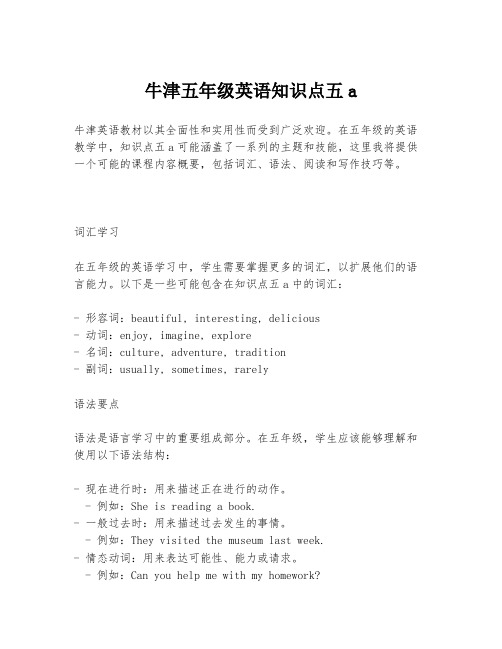
牛津五年级英语知识点五a牛津英语教材以其全面性和实用性而受到广泛欢迎。
在五年级的英语教学中,知识点五a可能涵盖了一系列的主题和技能,这里我将提供一个可能的课程内容概要,包括词汇、语法、阅读和写作技巧等。
词汇学习在五年级的英语学习中,学生需要掌握更多的词汇,以扩展他们的语言能力。
以下是一些可能包含在知识点五a中的词汇:- 形容词:beautiful, interesting, delicious- 动词:enjoy, imagine, explore- 名词:culture, adventure, tradition- 副词:usually, sometimes, rarely语法要点语法是语言学习中的重要组成部分。
在五年级,学生应该能够理解和使用以下语法结构:- 现在进行时:用来描述正在进行的动作。
- 例如:She is reading a book.- 一般过去时:用来描述过去发生的事情。
- 例如:They visited the museum last week.- 情态动词:用来表达可能性、能力或请求。
- 例如:Can you help me with my homework?阅读理解阅读理解能力的提高是英语教学的关键。
学生应该能够阅读并理解不同类型和难度的文本。
以下是一些可能的阅读练习:- 故事:理解故事情节和角色。
- 信息文本:获取和分析信息。
- 诗歌:欣赏语言的韵律和节奏。
写作技巧写作是表达思想和信息的重要方式。
在五年级,学生应该能够:- 写叙述文:描述一个事件或经历。
- 写说明文:解释一个过程或概念。
- 写信件:与他人交流信息或情感。
口语交流口语交流能力也是英语学习中不可或缺的一部分。
学生应该能够:- 参与对话:与他人进行日常交流。
- 表达意见:清晰地表达自己的观点和感受。
- 描述事物:使用适当的词汇和结构来描述人、地点或事物。
文化意识了解和欣赏不同的文化也是英语教学的一部分。
学生可以通过学习:- 不同国家的节日和习俗。
牛津小学英语5A知识梳理
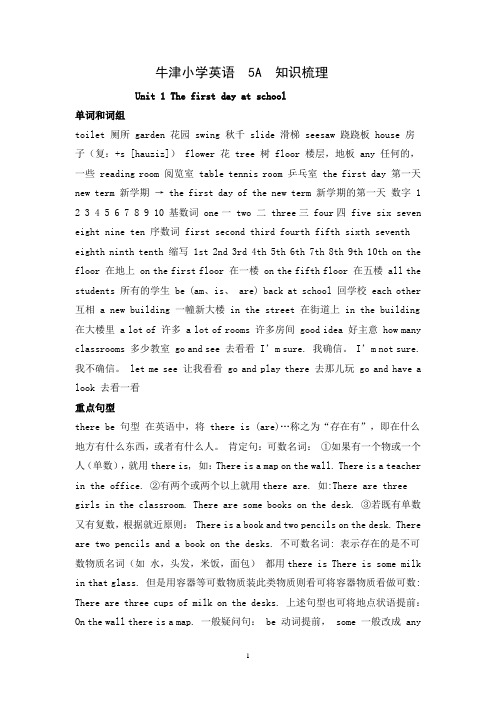
牛津小学英语5A 知识梳理Unit 1 The first day at school单词和词组toilet 厕所 garden 花园 swing 秋千 slide 滑梯 seesaw 跷跷板 house 房子(复:+s [hauziz]) flower 花 tree 树 floor 楼层,地板 any 任何的,一些 reading room 阅览室 table tennis room 乒乓室 the first day 第一天new term 新学期→ the first day of the new term 新学期的第一天数字 1 2 3 4 5 6 7 8 9 10 基数词 one一 two 二 three三 four四 five six seven eight nine ten 序数词 first second third fourth fifth sixth seventh eighth ninth tenth 缩写 1st 2nd 3rd 4th 5th 6th 7th 8th 9th 10th on the floor 在地上 on the first floor 在一楼 on the fifth floor 在五楼 all the students 所有的学生 be (am、is、 are) back at school 回学校 each other 互相 a new building 一幢新大楼 in the street 在街道上 in the building 在大楼里 a lot of 许多 a lot of rooms 许多房间 good idea 好主意 how many classrooms 多少教室 go and see 去看看I’m sure. 我确信。
I’m not sure. 我不确信。
let me see 让我看看 go and play there 去那儿玩 go and have a look 去看一看重点句型there be 句型在英语中,将there is (are)…称之为“存在有”,即在什么地方有什么东西,或者有什么人。
牛津5A语法知识汇总
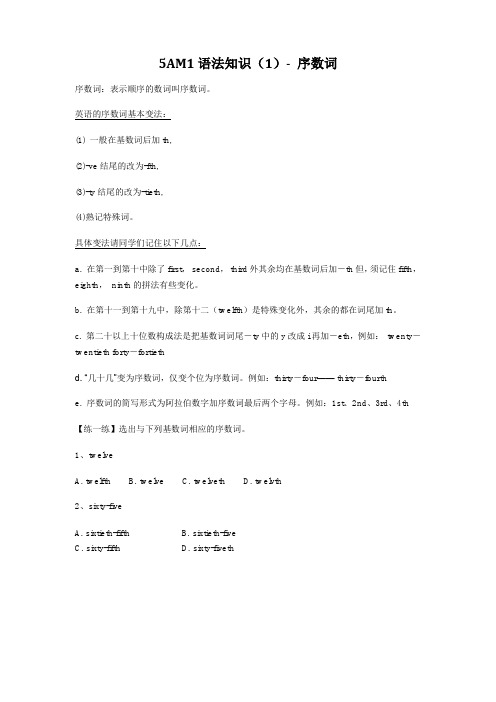
5AM1语法知识(1)- 序数词序数词:表示顺序的数词叫序数词。
英语的序数词基本变法:(1) 一般在基数词后加th,(2)-ve结尾的改为-fth,(3)-ty结尾的改为-tieth,(4)熟记特殊词。
具体变法请同学们记住以下几点:a. 在第一到第十中除了first,second,third外其余均在基数词后加-th但,须记住fifth,eighth,ninth的拼法有些变化。
b. 在第十一到第十九中,除第十二(twelfth)是特殊变化外,其余的都在词尾加th。
c. 第二十以上十位数构成法是把基数词词尾-ty中的y改成i再加-eth,例如:twenty-twentieth forty-fortiethd. “几十几”变为序数词,仅变个位为序数词。
例如:thirty-four—— thirty-fourthe. 序数词的简写形式为阿拉伯数字加序数词最后两个字母。
例如:1st、2nd、3rd、4th【练一练】选出与下列基数词相应的序数词。
1、twelveA. twelfthB. twelveC. twelvethD. twelvth2、sixty-fiveA. sixtieth-fifthB. sixtieth-fiveC. sixty-fifthD. sixty-fiveth5AM1语法知识(2)- 介词使用交通工具时的介词表达介词规则:by:骑车、乘(驾)车、乘船、乘飞机可以使用介词by。
1. by 后跟“光棍”名词,即名词不加任何修饰。
如:by bike/bus/car/train/ship/boat/plane. 例如:She is going to the Great Wall (长城)by car/ bus.2. by ship 可用by sea表示;by plane 可以用by air 表示。
例如:a. How long does it take by ship/sea?b. They often come back by plane/air.in/on:步行、骑车、乘车、乘船、乘飞机可以使用介词in/on。
牛津小学英语5A单词、词组、句型小结

牛津小学英语5A基础知识小结(单元要点、四会单词、词组、句型总结)Unit 1 The first day at school四会单词:三会单词:first 第一(的);先;首先term 学期second 第二(的)back 回(原处)third第三(的)happy 高兴的day (一)天;白天glad 高兴的;乐意的all 所有的;全部building 大楼;建筑物any 任何的;一些sports hall 体育活动房reading room 阅览室table tennis 乒乓球computer room 电脑室table tennis room 乒乓球室sure 有把握的toilet 厕所floor (楼房的)层;地面;地板swing 秋千garden 花园slide 滑梯;滑道house 房子;住宅see-saw 跷跷板(游戏)flower 花street 街道四会词组:三会词组:the first day第一天the new term新学期all the students全体学生back at school回来上课at school 在学校;在上课each other 互相a lot (of) 许多;大量Glad to see you. 见到你很高兴。
how many多少,几个?play there 在那里玩on the first floor在二楼in the street 在大街上on the second floor在三楼on the third floor在四楼语音:a new house新房子/ / cake grape plate some flowers一些花name table plane near the garden在花园附近take tape Kate四会句型:1.----Is there a/an …in the …? ----Yes,there is./No,there isn’t.2.----Are there any…in the…? ----Yes,there are.No,there aren’t.3.----How many …are there in the …?----There are …4.----Shall we go and play there?----Good idea.Unit 2 A new house四会单词:三会单词:live 居住;生活parent 父;母bedroom 卧室;寝室parents 父母亲bathroom 浴室;盥洗室kitchen 厨房sitting-room 起居室world 世界dining-room 餐厅telephone 电话机;电话study 书房;学习,攻读mouse 鼠large 大的mouth 嘴beside 在……旁边;靠近三会词组:bed 床her parents她的父母wall 墙 a map of the world一幅世界地图lamp 灯between the buildings在建筑之间sofa (长)沙发in the cat’s mouth在猫嘴里between 在(两者)之间;在……中间under 在……下面语音:behind 在……后面/ / black happydoor 门hat cap rabbit四会词组:tap bag jacketlive in 居住在Japaneseon the wall 在墙上between the map and the bed在地图和床之间in/on/besi de… the wall/map/desk…四会句型:1.----What’s in/on/under/behind/beside/between …?----There’s a/an …in/on/under/behind/beside/between …(There are some …in/on/under/behind/beside/between …)2.There isn’t a/an …(There aren’t any …)3.Here’s a/an … for you.(Here are some … for you.)Unit 3 At a music lesson四会单词:三会单词:lesson 课;功课start 开始can 能music 音乐can’t 不能violin 小提琴sing 唱;唱歌follow 跟随;仿效song 歌曲together 一起dance 跳舞guitar 吉他play 演奏learn 学;学会三会词组:listen 听in the music room在音乐室listen to 听have a music room上音乐课swim 游;游泳follow me跟着我make 做;制造play the violin拉小提琴ride 骑(马、自行车)play the piano弹钢琴put 放;摆play the guitar弹吉他skate 溜冰;滑冰play the accordion拉手风琴ski 滑雪let’s start 让我们开始吧model 模型sing it together 一起唱ready 准备好的put a book on your head 把书放在你的头上begin 开始find him 找到他四会词组:under the teacher’s desk 在讲台下at an Art lesson在美术课上sing the song 唱歌语音:/a:/ after basket class listen to me 听我的dance asklisten to the song 听这首歌star park artlearn the song 学这首歌garden card smart sing and dance 边唱边跳sharpenermake a model plane 做模型飞机ride a bike 骑自行车四会句型:1.----I can …What can you do? ----I can … (can后动词用原形)2.The girl can dance,but the boy can’t.He can sing.3.----Can you put the book on your head? ----Yes,I can./No,I can’t.4.Where’s Ben?Who can find him?Unit4 Halloween四会单词:三会单词:family 家庭Halloween 万圣节前夕(10月31日)thing 东西;物品tomorrow 明天need 需要pumpkin 南瓜vase 花瓶lantern 灯笼horse 马change 找头,零钱candle 蜡烛Saturday 星期六chicken 鸡Sunday 星期天duck 鸭;鸭肉with 和pig 猪or 或者evening 傍晚;晚上if 如果,假如work 工作三会词组:buy 买 a Halloween partymask 面具pumpkins lanternselse 别的,期他的Here’s your change,cook 烹调;做饭on Saturdays/Sundaystry 试play table tennis with our friends四会词组:like readingin the evening 在晚上his family 他的家庭语音:/i:/ he she these zebrabuy things 买东西bee be needneed some flowers and a vase需要一些花和一个花瓶buy some masks买一些面具season tea beachWhat else? 别的什么?teach teachercook some rice 做饭each peachdon’t work 不工作四会句型:1.----Do you like …? ----Yes,I do./No,I don’t. I like …(like后如果直接跟动词,动词要加ing)2.----I like …What do you like? ----I like …3.----What do you need? ----I need …----What else do you need? ---…,please.Unit 6 Doing housework四会单词:三会单词:morning 早晨,上午housework 家务劳动ring (钟铃等)响free 自由的;空闲的sweep 扫,扫除homework 家庭作业help 帮助clean 把……弄干净;擦干净Maths (口语)数学speak 说话stand 站;立三会词组:sit 坐clean the window 擦窗户sleep 睡觉Sunday morning 星期天早晨jump 跳跃do housework 做家务run 跑,奔跑do one’s homework 做家作walk 步行;散步make a cake 做蛋糕wash 洗涤,冲洗Come and help me,please.请来帮我。
牛津英语5A重点句型总结
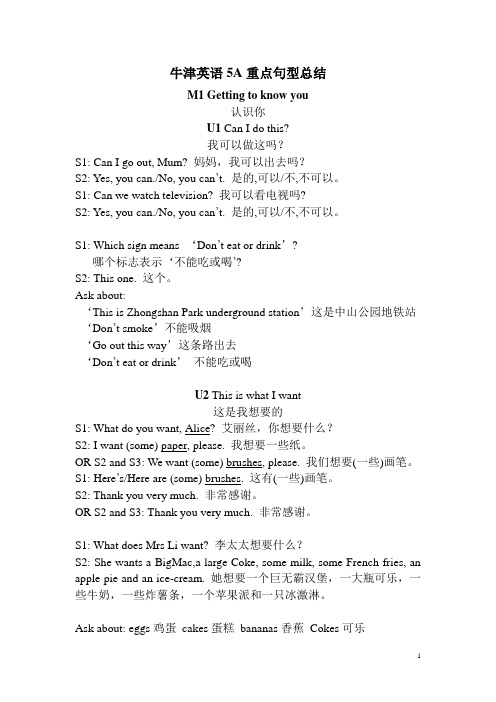
牛津英语5A重点句型总结M1 Getting to know you认识你U1 Can I do this?我可以做这吗?S1: Can I go out, Mum? 妈妈,我可以出去吗?S2: Yes, you can./No, you can’t. 是的,可以/不,不可以。
S1: Can we watch television? 我可以看电视吗?S2: Yes, you can./No, you can’t. 是的,可以/不,不可以。
S1: Which sign means ‘Don’t eat or drink’?哪个标志表示‘不能吃或喝’?S2: This one. 这个。
Ask about:‘This is Zhongshan Park underground station’这是中山公园地铁站‘Don’t smoke’不能吸烟‘Go out this way’这条路出去‘Don’t eat or drink’不能吃或喝U2 This is what I want这是我想要的S1: What do you want, Alice? 艾丽丝,你想要什么?S2: I want (some) paper, please. 我想要一些纸。
OR S2 and S3: We want (some) brushes, please. 我们想要(一些)画笔。
S1: Here’s/Here are (some) brushes. 这有(一些)画笔。
S2: Thank you very much. 非常感谢。
OR S2 and S3: Thank you very much. 非常感谢。
S1: What does Mrs Li want? 李太太想要什么?S2: She wants a BigMac,a large Coke, some milk, some French fries, an apple pie and an ice-cream. 她想要一个巨无霸汉堡,一大瓶可乐,一些牛奶,一些炸薯条,一个苹果派和一只冰激淋。
牛津小学英语5A Unit1-Unit4要点归纳
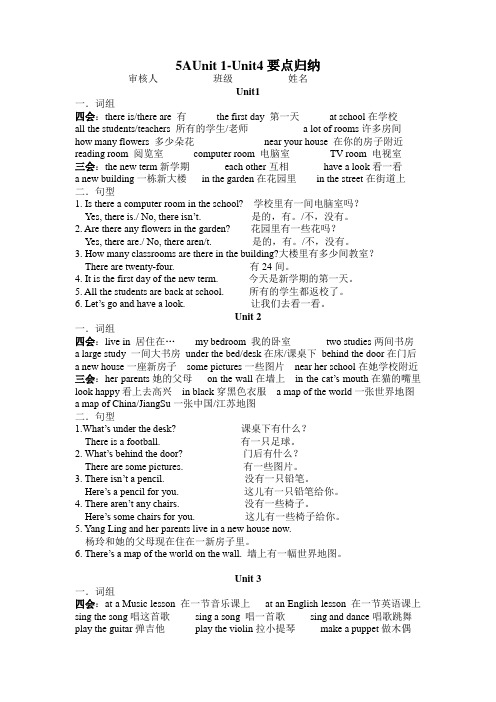
5AUnit 1-Unit4要点归纳审核人___________班级___________姓名____________Unit1一.词组四会:there is/there are 有the first day 第一天at school在学校all the students/teachers 所有的学生/老师 a lot of rooms许多房间how many flowers 多少朵花near your house 在你的房子附近reading room 阅览室computer room 电脑室TV room 电视室三会:the new term新学期each other互相have a look看一看a new building一栋新大楼in the garden在花园里in the street在街道上二.句型1. Is there a computer room in the school? 学校里有一间电脑室吗?Yes, there is./ No, there isn’t. 是的,有。
/不,没有。
2. Are there any flowers in the garden? 花园里有一些花吗?Yes, there are./ No, there aren/t. 是的,有。
/不,没有。
3. How many classrooms are there in the building?大楼里有多少间教室?There are twenty-four. 有24间。
4. It is the first day of the new term. 今天是新学期的第一天。
5. All the students are back at school. 所有的学生都返校了。
6. Let’s go and have a look. 让我们去看一看。
Unit 2一.词组四会:live in 居住在…my bedroom 我的卧室two studies两间书房a large study 一间大书房under the bed/desk在床/课桌下behind the door在门后a new house一座新房子some pictures一些图片near her school在她学校附近三会:her parents她的父母on the wall在墙上in the cat’s mouth在猫的嘴里look happy看上去高兴in black穿黑色衣服 a map of the world一张世界地图a map of China/JiangSu一张中国/江苏地图二.句型1.What’s under the desk? 课桌下有什么?There is a football. 有一只足球。
- 1、下载文档前请自行甄别文档内容的完整性,平台不提供额外的编辑、内容补充、找答案等附加服务。
- 2、"仅部分预览"的文档,不可在线预览部分如存在完整性等问题,可反馈申请退款(可完整预览的文档不适用该条件!)。
- 3、如文档侵犯您的权益,请联系客服反馈,我们会尽快为您处理(人工客服工作时间:9:00-18:30)。
五年级英语语法总结
一.1.there be 句型表示“某处有某物”。
be动词要根据“物”的单复数变化:单数is,复数are, 不可数名词用is.
例:There is a book on the desk.
There are some books on the desk.
There is some orange juice in the glass.
be 句型变一般疑问句时, be动词提前, some 变为any。
例:Is there a book on the desk Yes, there is.
Are there any books on the desk No, there aren’t.
Is there any orange juice in the glass Yes, there is.
3. 就近原则:be动词根据离它最近名词单复数选择is或 are。
例:There is a swing and two slides in the garden.
There are two slides and a swing in the garden.
4.某处没有某物
例:There is no bread on the plate.
There isn’t any bread on the plate.
There aren’t any pictures on the plate.
二.have, has表示“某人有某物”
1.have用于I, we, you, they或复数人称:
I/We/You/They/Ben and Mike have a table.
2.has 用于第三人称单数( he, she, it,单数人称)
He/She/My father has a bike.
3.疑问句:What do you have I have a doll.
What does he have He has a book..
三.how many (多少)后的可数名词要用复数。
How many buses are there There are twenty.四.介词归类
in on under behind near
在…里面在…上面在…下面在…后面在…旁边
五.疑问词归类
what where when which why
什么哪里什么时间哪一个为什么
who who’s whose how how old
谁是谁谁的怎么样多大
how many how much how about what time
多少多少(钱)…怎么样几点
六.星期归类
Sunday Monday Tuesday Wednesday
星期天星期一星期二星期三
Thursday Friday Saturday
星期四星期五星期六
在星期几前用介词on
I make model planes on Sunday.
七.like + 名词复数 I like toy horses.
like + 动词ing (V-ing) I like cooking.
八.现在进行时:表示正在进行的动作。
构成:be动词(am/is/are)+V-ing
如变一般疑问句, be动词提前, 见到“我”变成“你”(I变you,we 变you)例: I am standing.→Are you standing Yes, I am.
He is sitting.→Is he sitting No, he isn’t.
We are running.→Are you running Yes, we are.
动词V + ing 的构成规则
1.一般情况下加ing: sleeping, playing, doing
2.一个元音+ 一个辅音结尾的词,双写这一辅音字母再加ing: running, sitting,
swimming
3.以不发音的e结尾的动词,去e加ing:have→having, write→writing, live→living,
like→liking, dance→dancing
九.do, does 都有“做”的意思,用在有动词的句子里,它们的用法区别如下:
1. does 用于第三人称单数(he, she, it, 单数人称)
What does he have He has a pot.
Does Mike go to school Yes, he does.
2. do用于其他人称(I, we, you, they, 复数人称)
How many blankets do you have I have two.
Do they like football No, they don’t.
十.代词
1.动词后用宾格: She can see me. Ms Wu teaches us English.
2.形容词性物主代词+名词: This is my book. Her pen is on the desk.
3.名词性物主代词后什么都不加: This book is mine. The pen on the desk is hers.
十一.开音节和闭音节
1.开音节有两种:①以元音字母结尾的音节叫开音节。
例:we, she, go
②以辅音字母+不发音的e结尾(r除外)的音节,也叫开音节。
例:name, white, driver,
baker等。
元音字母在开音节中读该字母的名称音:a/ /, e/ /, i/ /, o/ /, u/ /
2.闭音节:以一个或几个辅音字母(r除外)结尾的重读音节叫闭音节。
例:map, desk,
sit, clock, cup等。
元音字母在闭音节中读短音:a/ /,e/ /, i/ /, o/ /, u/ /.
①在开音节中读/ /: bookcase, baseball, late, make, plane
②在闭音节中读/ /:bag, cap, tap, happy, hat, black
③在辅音字母f, n, s前一般发/ /:after, basketball, class
e①在开音节中读/ /:evening, see, me
②在闭音节中读/ /:desk, dress, egg, help
i①在开音节中读/ /:bike, hide, nine
②在闭音节中读/ /:big, chips, ill, in
o①在开音节中读/ /:close, hello, over, nose
②在闭音节中读/ /:on, job, hot, dog。
